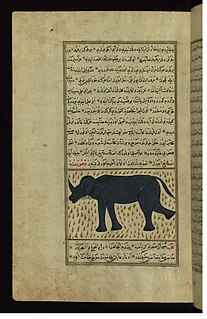 W
WAnqa, also spelled 'Anqa' , or Anka, or Anqa Mughrib or Anqa al-Mughrib is a large mysterious or fabulous female bird in Arabian mythology. She is said to fly far away and only appear once in ages. However, it is also said that she can be found at "the place of the setting of the sun".
 W
WBahamut or Bahamoot is a sea monster that lies deep below, underpinning the support structure that holds up the earth, according to Zakariya al-Qazwini.
 W
WGhoul is a demon-like being or monstrous humanoid originating in pre-Islamic Arabian religion, associated with graveyards and consuming human flesh. In modern fiction, the term has often been used for a certain kind of undead monster.
 W
WJinn – also romanized as djinn or anglicized as genie – are supernatural creatures in early pre-Islamic Arabian and later Islamic mythology and theology. Like humans, they are created with fitra, born as believers, but their attitude depends on whether they accept God's guidance. Since jinn are neither innately evil nor innately good, Islam acknowledged spirits from other religions, and was able to adapt spirits from other religions during its expansion. Jinn are not a strictly Islamic concept; they may represent several pagan beliefs, and beliefs in the early Abrahamic religions integrated into Islam.
 W
WThe Karkadann is a mythical creature said to have lived on the grassy plains of India and Persia.
 W
WKuyūthā is the cosmic bull in medieval Islamic cosmography. It is said to carry on its back the angel who shoulders the earth and the rock platform upon which the angel stands. The bull is said to stand on the giant fish or whale, Bahamut.
 W
WAl-Mi'raj or Almiraj is a mythical beast said to live on a mysterious island called Jazirah al-Tennyn within the confines of the Indian Ocean. It takes the form of a rabbit with a unicorn-like horn or horns. According to legend, the beast was a gift given to Alexander the Great from the inhabitants of the island after he killed a large dragon that had been eating the livestock of the people there. It is mentioned in Zakariya Ibn Muhammad Al-Qazwini's Marvels of Things Created and Miraculous Aspects of Things Existing.
 W
WIn Arab folklore, the Nasnas is a monstrous creature. According to Edward Lane, the 19th century translator of The Thousand and One Nights, a nasnas is "half a human being; having half a head, half a body, one arm, one leg, with which it hops with much agility".
 W
WThe Nephilim are mysterious beings or people in the Hebrew Bible that are large and strong; the word Nephilim is loosely translated as giants in some Bibles but left untranslated in others. Some traditional Jewish explanations interpret them as fallen angels. The main reference to them is in Genesis, but the passage is ambiguous and the identity of the Nephilim is disputed.
 W
WThe roc is an enormous legendary bird of prey in the popular mythology of the Middle East.
 W
WShâd'havâr or Âras (آرس) is a legendary creature from medieval Muslim bestiaries resembling a unicorn. Al-Qazwini said that it lives in the country of Rūm (Byzantium) and that it has one horn with 42 hollow branches which, when the wind passes through them, produces a pleasant sound that makes the animals sit around and listen. Horns of those creatures, sometimes gifted to kings, can be played like flutes. When played on one side, they produce a cheerful sound, and when on the other, the music is so sad it makes people cry.
 W
WShahmaran, is a mythical creature, half woman and half snake, found with different variations in the folklore of Iran, Anatolia, the Armenian Highlands, Iraq, and of the Kurds.
 W
WWere-hyena is a neologism coined in analogy to werewolf for therianthropy involving hyenas. It is common in the folklore of the Arabian Peninsula, the Levant, North Africa, the Horn of Africa, and the Near East as well as some adjacent territories. Unlike werewolves and other therianthropes, which are usually portrayed as being originally human, some werehyena lore tells of how they can also be hyenas disguised as humans.